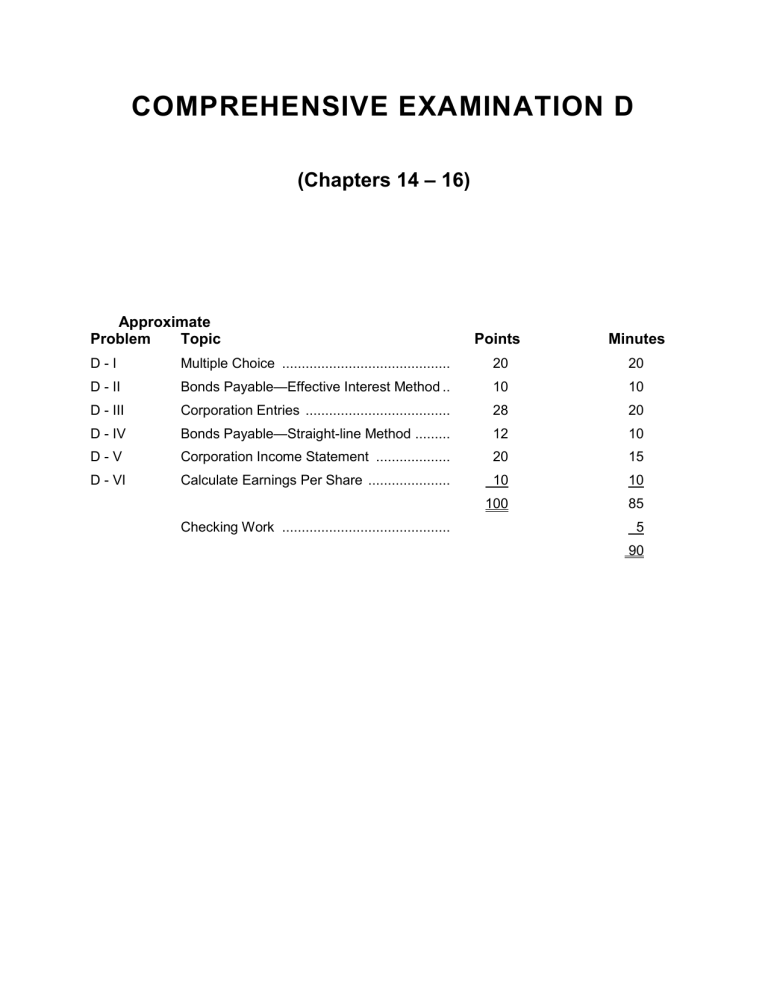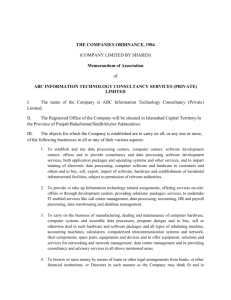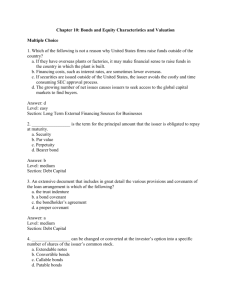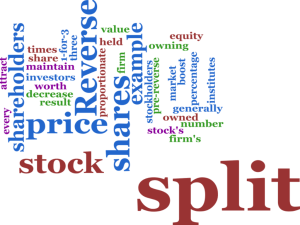comprehensive examination d

D - III
D - IV
D - V
D - VI
COMPREHENSIVE EXAMINATION D
(Chapters 14 – 16)
Approximate
Problem Topic Points Minutes
D - I
D - II
Multiple Choice ...........................................
Bonds Payable —Effective Interest Method ..
20
10
20
10
Corporation Entries .....................................
Bonds Payable —Straight-line Method .........
28
12
Corporation Income Statement ................... 20
Calculate Earnings Per Share ..................... 10
100
Checking Work ...........................................
20
10
15
10
85
5
90
Problem D - I — Multiple Choice (20 points)
Circle the one best answer.
1. The amortization of premium on bonds payable a. will increase bond interest expense. b. should take place over a period not to exceed 40 years. c. will decrease bond interest expense. d. will increase bond interest revenue.
2. A corporation issued $600,000 of 8%, 5-year bonds on January 1, at 102. Interest is paid semi-annually on January 1 and July 1. If the corporation uses the straight-line method of amortization, the amount of bond interest expense to be recognized on July 1 is a. $48,000. b. $24,000. c. $25,200. d. $22,800.
3. Which of the following is not a condition that indicates a capital lease? a. The lease transfers ownership to lessee. b. The lessee may purchase the property at fair market value anytime during the lease period. c. The lease term is equal to 75% or more of the economic life of the property. d. The present value of lease payments equals or exceeds 90% of the fair market value of the property.
4. A $200,000, 8%, 20-year bond was issued at 98. The proceeds received from the bond issue are a. $200,000. b. $198,000. c. $204,000. d. $196,000.
5. Which of the following would not be shown net of income taxes on the income statement? a. Loss from operations of discontinued segment b. Loss due to expropriation of property by a foreign government c. Loss on write-down of inventory d. Cumulative effect of a change in accounting principle
6. A prior period adjustment a. appears on the income statement as an extraordinary item. b. example is a correction of a prior period error, made directly to retained earnings. c. is made when preferred dividends in arrears are finally paid. d. is made to reverse an adjusting entry.
7. Ewing Company converts 1,000 preferred shares into 10,000 common shares. The preferred shares had been previously acquired for $24,000. The market value of the preferred shares was $30 per share, and the market value of the common shares was
$4 per share on the date of conversion. Common shares should be credited for a. $4,000. b. $24,000.
c. $30,000. d. $40,000.
8. X Company has the following shares:
$6 Preferred shares, no par value, cumulative
Common shares, no par value
$300,000
$600,000
Preferred shares were issued for $100 per share, and common shares were issued for
$50 per share. Preferred stock dividends are in arrears for 1999 and 2000. If the company declares and pays $45,000 in dividends in 2001, the amount received by the preferred shareholders would be a. $36,000. b. $18,000. c. $54,000. d. $45,000.
9. Y Company had 2,000 no par $3 noncumulative preferred shares and 150,000 no par common shares issued on December 31, 2001. During 2001, the company had net income of $170,000 and paid dividends of $50,000. Earnings per share for 2001 would be a. $1.13. b. $0.80. c. $1.12. d. $1.09.
10. Which one of the following would not be classified as an extraordinary item on the income statement? a. Losses attributable to an unexpected labour strike b. Expropriation of property by a foreign government c. Effects of a rare major casualty d. Loss because of a newly enacted governmental regulation
Problem D - II — Bonds Payable—Effective Interest Method (10 points)
On April 20, 2001, Shine Corporation issued $40,000 of 4-year, 12% bonds. Interest is payable semi-annually on October 31 and April 30. The bonds were sold for $42,585 and will yield 10% on an annual basis. (All amounts are rounded to the nearest dollar.) The investor will hold the bonds to maturity. Shine Corporation uses the effective interest method to amortize any premium or discount.
Instructions
Assuming the investor’s fiscal year is the calendar year, give all of the investor’s entries related to the bonds for 2001 as follows:
(1) April 30 (purchase)
(2) October 31 (interest and amortization)
(3) December 31 (adjusting)
Problem D - III — Corporation Entries (28 points)
Russell Corporation shareholders' equity consisted of the following on January 1, 2001:
Shareholders' Equity
Share capital
$8 Preferred shares, no par value, cumulative,
50,000 shares authorized, 30,000 shares issued
Common shares, no par value, 1,000,000 shares authorized, 400,000 shares issued
$ 3,000,000
Total share capital
Retained earnings (Note A)
Total shareholders' equity
10,000,000
13,000,000
4,100,000
$17,100,000
Note A: Preferred dividends are in arrears for 2000.
Instructions
Prepare the appropriate journal entries, if any, for the following transactions in 2001. You may omit journal entry explanations but you should show calculations.
1/25/01 Issued 60,000 common shares for $40 per share.
2/18/01 The Board of Directors declared a cash dividend on preferred and common shares totalling $700,000, payable on March 15, to shareholders of record on February 28.
(Record dividends payable on preferred and common shares in separate accounts.)
2/28/01 Date of record for cash dividends on preferred and common shares.
3/15/01 Paid the cash dividend to preferred and common shareholders.
5/20/01 Declared a 10% stock dividend on the common shares, payable on June 15, to shareholders of record on May 31. The market value of Russell Corporation's common shares was $45 per share.
6/15/01 Distributed stock dividend to common shareholders.
7/10/01 Converted 1,000 preferred shares to 2,000 common shares. On the day of the conversion, the preferred shares were trading for $110 per share, and the common shares were trading for $100 per share.
8/13/01 Issued 25,000 common shares for land. The asking price of the land was $700,000; the fair market value was $750,000.
9/30/01 The Board of Directors declared and issued immediately a 2-for-1 stock split on all the common shares. The market value of the common shares was $30 per share.
11/12/01 Sold 20,000 common shares for equipment valued at $600,000.
Problem D - IV — Bonds Payable—Straight-line Method (12 points)
Ripken Company issues $200,000 of 5%, 10-year bonds on January 1, 2001 at 103. Interest is payable semi-annually on July 1 and January 1. The issue was correctly recorded. The company uses the straight-line method of amortization.
Instructions
(a) Journalize the entries for bond interest on (1) July 1, 2001 and (2) December 31, 2001.
(b) Show the balance sheet presentation of the bonds at December 31, 2001.
Problem D - V — Corporation Income Statement (20 points)
Tanner Company has income from continuing operations of $350,000 for the year ended
December 31, 2001. It also has the following items (before considering income taxes): (1) an extraordinary fire loss of $80,000, (2) a gain of $50,000 on the sale of a discontinued division,
(3) a cumulative change in an accounting principle that resulted in an increase in prior years' amortization of $30,000, and (4) a correction of an error in last year's financial statements that resulted in a $20,000 understatement of 2000 net income. Assume all items are subject to income taxes at a 30% tax rate.
Instructions
(a) Prepare an income statement, beginning with income from continuing operations.
(b) Indicate the statement presentation of any item not included in (a) above.
Problem D - VI — Calculate Earnings Per Share (10 points)
At December 31, 2001, Oliver Company had $500,000 of no par value $9 preferred shares issued at $100 per share, and $1,000,000 of no par value common shares issued at $5 per share. Net income for the year was $933,000.
Instructions
Calculate the earnings per share under the following independent assumptions:
(a) The dividend on preferred shares was not declared, and the preferred shares are noncumulative.
(b) The dividend on preferred shares was not declared, and the preferred shares are cumulative. The common shares remained unchanged during the year.









